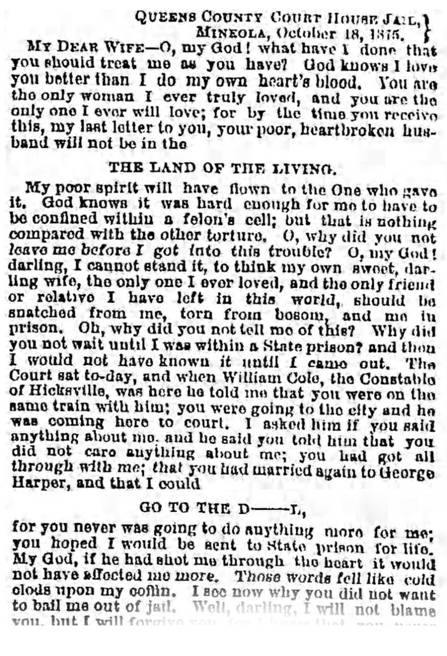|
|
JUNE 2020
|
|

|
In the years following the Civil War,
Hicksville
was not a village which one expected to see mentioned in front-page news
- newspapers usually reserved such honors for the criminal, the gory,
or the terrifying. Thus, if
it got mentioned, it probably was because of a railroad mishap which had
killed or maimed someone.
Early in September 1875, however, something quite different put the
village in the news - and not just in Long Island and
Manhattan
, but beyond, in
Oswego
, in
Philadelphia
, in
Washington
, and who-knew-where-else. It
was the most unlikely news story ever to emanate from
Hicksville
. Staid businessman George
de Languillette was challenged to a duel, and given a choice of pistols
or swords. To add more spice
to the tale, the challenger's wife, a summer resident of
Hicksville
, was a clairvoyant, and she was well-remembered for her connection to a
notorious murder trial.
The news clipping below covers the beginning of the incident.
Two clarifications
are needed in order to understand it properly.
First, before 1899,
Nassau
County
did not exist;
Queens
County
extended from Brooklyn to
Suffolk
County
. Second, Captain Hussey and
his Mulligan Guards were fictitious characters, popularized by a music
hall song; their two known skills were parading smartly and drinking
hard.
|
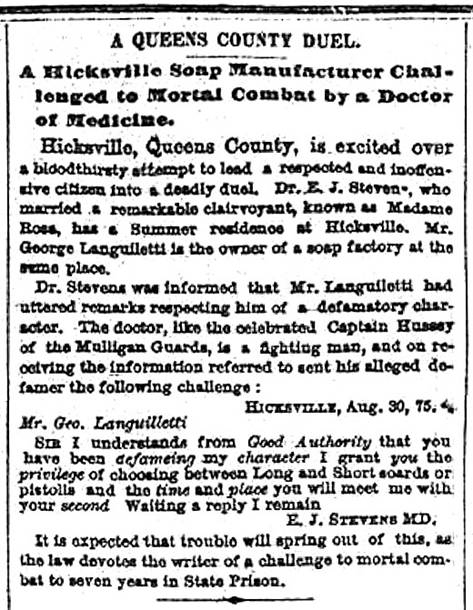
|
|
Brooklyn
Daily Eagle, September 8, 1875
|
Hmmmm....
"A remarkable clairvoyant" - really?
What can we learn about her, or for that matter, about any of the
others involved? Was there
ever a duel?
Let's find out whatever we can, and en route get a glimpse of 1870s
life on
Long Island
.
|
***
|
|
George de Languillette
and
his father, Ernst
|
In September of 1875, if you lived in
Hicksville
, you knew of George's father, Ernst Heinrich de Languillette, one of
the village's early German immigrants.
He had served as Postmaster, and he had played a key role in the
early years of the Fire Department.
Townspeople shopped at his store on Broadway, and they looked
forward each year to the fair held by the Oyster Bay Town Agricultural Society - a group of which Ernst was
the president, as well as the mortgage-holder for its fair grounds.
Even if Hicksvillians did not bathe using the locally-made soap,
they knew that in the previous year, Ernst had acquired the works that
made it.
|
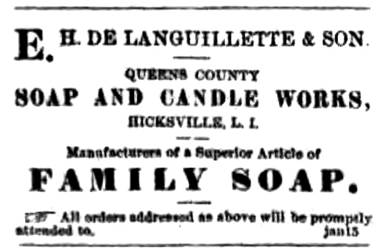
|
|
Queens County Sentinel, April
30, 1874
"&
SON" meant George de Languillette, who
actually operated the works - his father once
proudly announced, "I am no soap boiler."
|
For a number of people in the village, or for their
friends, old Mr. de Languillette was a landlord.
Over his nearly fifty years in the village, he had become one of
its wealthier residents, in part because of his many investments in
regional real estate.
In the map below, note how much of the downtown Broadway frontage he
owned. Note also that at the
western intersections at "Nicholay" Street, the properties were
owned by families of his in-laws, respectively named Bussmann
and Quaritius.
Ernst may have helped them acquire these choice spots.
|
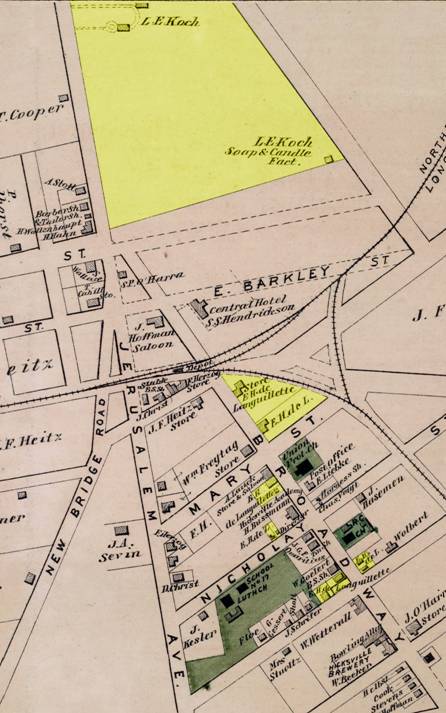
|
|
Core of Downtown Hicksville
circa 1875
Beers, Comstock & Cline,
Atlas of
Long Island
, etc., 1873
digitalcollections.nypl.org
(modified for this article)
Properties owned by Ernst Heinrich de Languillette
are highlighted in yellow.
|
His acquisition of the Soap and Candle Factory was too recent to be reflected in the Atlas.
When this map was drafted, Louis E. Koch still owned the factory
and the large farm property on which it stood.
By the spring of 1874, he had traded them to de Languillette, in
exchange for a number of real estate parcels closer to
New York
, including some properties in
Brooklyn
.
It is difficult to learn much about George himself.
He seems to have tried working as a commercial traveler (i.e.,
traveling salesman), but he was stymied by chronic health problems.
On the 1870 U.S. Census, again likely because of his health, he
was listed as a "retired grocer" - at the young age of 21.
By early 1875, George had been in charge of factory operations for
almost a year, and he had proved himself to his father.
Ernst felt sufficiently confident in George to retire from the
soap and candle business, leaving him as senior partner.
Thus, young de Languillette took on a junior partner, Ludwig
Friedman, to help shoulder responsibilities.
|
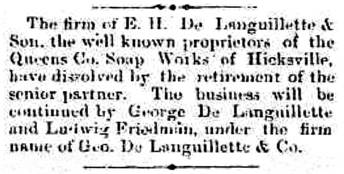
|
|
Southold
Long Island
Traveler, February 11, 1875
|
Hicksvillians seem to have respected George de
Languillette. Reporters
sometimes called him "gritty" - but they also seem to have worried
about him. Newspapers were
known to comment on his health.
|
***
|
|
Madame Rosa
and
a famous murder trial
|
Just
who was this woman? One
newspaper report alleged that she had had six husbands, as well as
several lovers. She denied
both allegations, saying that she had been married to only three
husbands, but had married one of them twice, years apart.
Although she said that her legal given name was Amy,
she once had testified under oath that it was Zimmel.
In different times and places, she had different names, which
makes Madame Rosa a tricky person to research.
Moreover, she sometimes said half-truths about herself.
Discerning the facts of her life from its fictions is difficult.
Per
the 1870 U.S. Census, she was 32 years old, and had been born in New
York State (she later said that her birthplace was Warwick, New York,
just north of the New Jersey border).
On that same census, she described her occupation as
"Clairvoyant," indicated that she had somewhat better-than-average
financial assets, and said that she owned real estate worth $5,000 -
likely a reference to her summer house and property in Hicksville.
|
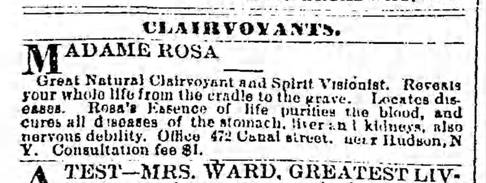
|
|
Brooklyn
Daily Eagle, February 11, 1877
|
|
*
|
In
1874, she acquired some measure of renown by testifying in defense of a
Brooklyn
woman accused of a notorious murder - testimony which in no way was
connected to her purported skills as a clairvoyant.
The explanation is lengthy, but intriguing.
The
year before, a fire broke out in
Williamsburg
, in the second-floor apartment of a Mr. and Mrs. Merrigan.
Neighbors rushed to the scene to extinguish it, but the couple
stood outside, trying to prevent people from fighting the fire.
The husband kept warning, "There's kerosene; don't go up"
and "There's no one up there."
His wife Sarah, who was pregnant, tried to push the helpful
neighbors away, and she cursed them loudly for their efforts.
The couple's pleas were futile. With
the fire out, police entered the apartment, and discovered the scorched
body of a woman (Margaret Hamill, a friend of Sarah since childhood).
The Coroner determined that Miss Hamill had died of strangulation
two days before the fire, and that the cause of the fire was arson.
Sarah Merrigan was charged with first-degree murder.
As
it happened, on the day she died, Miss Hamill earlier had accompanied
Mrs. Merrigan to
Manhattan
, to consult with Madame Rosa. At
the ensuing trial, the defense implied that it would put much stock in
Rosa
's testimony about the consultation.
|
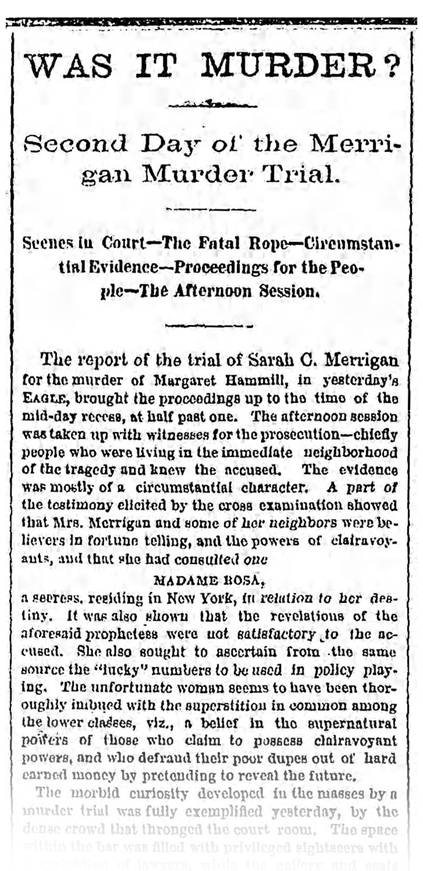
|
|
Brooklyn
Daily Eagle, October 28, 1874
|
The
following summarizes the defendant's account of the events that led to
Margaret Hamill's death:
Mrs.
Merrigan wanted to "play the numbers."
She and Margaret Hamill first visited a traveling gypsy, who
instructed them on how to use certain body measurements to predict their
respective futures, and thus learn when it would be fortuitous to play.
The pair next visited Madame Rosa, Sarah wanting to know which
numbers to play.
The two women then went to Mrs. Merrigan's home, in order to measure
their respective necks, toes, etc. Hamill
stood on a chair, so that the pregnant Merrigan need not bend too far to
measure Hamill's toes. That
job done, she continued to stand on the chair while measuring her own
neck, using a few yards of clothes line as a measuring tape.
To make the job easier, she draped the excess over a nearby open
door, and had Merrigan tie both ends to the knob on the opposite side,
to prevent the clothes line from slipping to the floor.
Sarah left the room to tend to other business.
When she returned, the chair was tipped over, and Hamill hung
from the door, dead.
Madame
Rosa's testimony was terse. She
confirmed that the two women had visited her on that day.
She added that, as she sensed Mrs. Merrigan was chronically
unlucky, she provided no numbers for her to play.
Instead, she counseled Sarah to never play the numbers game at
all. The women left.
Having
constructed this narrative to establish the possibility of accidental
death by hanging, the defense promptly abandoned it - perhaps because
a prosecution expert already had ruled out hanging as cause of death,
testifying that marks on the body showed the clothes line had been
pulled backward horizontally, not upward, as it strangled the deceased.
Instead, the defense argued that Merrigan had gone insane and tragically
killed her lifelong friend. It
offered multiple reasons - but no evidence - for thinking her
capable of madness. First,
insanity had "saturated her mother's family."
Second, a doctor testified that "some women" are subject to
fits of insanity during their second trimester of pregnancy.
Near the end of its closing argument, the defense abruptly
introduced a third possibility - perhaps Merrigan was an undiagnosed
epileptic who, zombie-like, had strangled Miss Hamill while in the
throes of an epileptic fit.
Incredibly, eight jurors were persuaded that this unsubstantiated
speculation constituted reasonable doubt.
Thus, justice - poetic justice, anyway - was served: the
trial ended with a hung jury.
Despite Madame Rosa's testimony having proved irrelevant to the
non-verdict, it brought her brief fame.
It was a case which left no doubt as to the killer's identity.
She testified for the defense, and the killer was not convicted.
That sounded like cause and effect to the public.
That Madame Rosa really
must be remarkable!
|
***
|
|
Edward J. Stevens
as
seen through his letters
|
If
the newspapers had not published several letters which Stevens wrote in
connection with this incident, we would know nothing about him.
He was born in
Sunderland
,
Massachusetts
about 1849, which means that he was nearly a decade younger than
Rosa
. Although
Sunderland
then was primarily agrarian, his father was a civil engineer.
As for Edward's title... it seemed unlikely that a true M.D.
would work selling a clairvoyant's patent medicine; indeed, one
newspaper claimed that "Doctor" Edward J. Stevens had recently
worked as a lowly nursing attendant in a mental hospital.
We already have seen the note which he sent to de Languillette as his
challenge. The recipient
immediately took it to Justice of the Peace Titus, and a warrant was
sworn for Stevens's arrest. Thus,
Constable William Cole went to the summer home of Madame Rosa to make
the arrest, where he found Stevens sunbathing in the yard.
Through politeness, Cole blundered - he permitted Stevens to
enter the house alone so as to don proper clothing.
While the constable waited outside, his quarry slid down a
clothes line from a window on the opposite side of the house, and ran
off.
De
Languillette soon received a threatening letter from the fugitive:
|
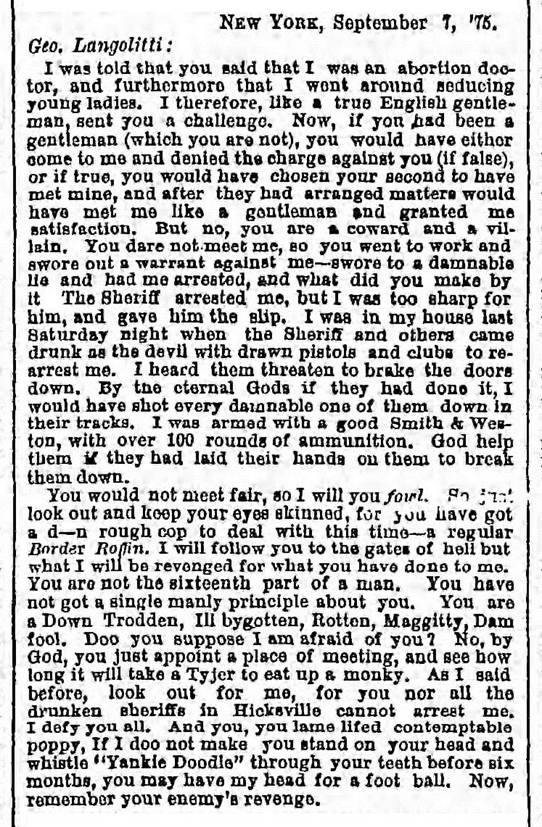
|
|
Brooklyn
Daily Eagle, September 14, 1875
|
Quite
the retort, no? Not long
afterward, Constable Cole received an even more abusive letter from
Stevens:
|
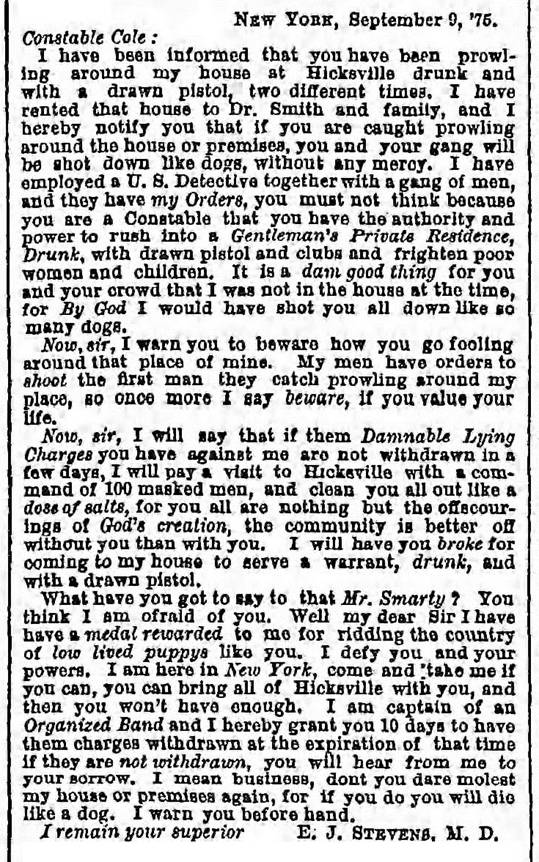
|
|
Brooklyn
Daily Eagle, September 14, 1875
|
Stevens
was in
Manhattan
, and brazenly unafraid.
William
Cole traveled to
Manhattan
, where with the help of a State Assemblyman he gained the cooperation
of local police. They helped
him complete the arrest on the evening of September 15th.
Curiously, although the Daily Tribune reported that the doctor was arrested only "after
considerable searching," he was found in the most obvious of places:
472 Canal Street
, Madame Rosa's workplace and usual home.
Edward Stevens then was taken to the Queens County Jail at
North Hempstead
. He asked to be represented
by the same attorney who had defended Mrs. Merrigan.
Arranging that would take time, and as he had been a fugitive, he
was denied bail. He was
jailed.
A week later, a Grand Jury was convened to investigate the matter.
News coverage was spotty; it suggests that Stevens first went
before the Grand Jury as early as September 23rd, and that
the jury reached its conclusion a month later.
During that month, he had remained in jail.
The Eagle reported that his wife had neither provided bail, nor hired
the defense attorney whom he had requested.
On October 18th the Grand Jury returned a "true
bill," meaning that prosecution would follow.
With
no evident help from his wife, and a trial now definite, Stevens lost
hope. He began to falsely
complain about bedbugs, and continued until he was handed a container of
poison sufficient to treat his bedding.
He drank the poison, but prompt medical attention - the elected
Assistant Sheriff on duty was a pharmacist - saved his life.
An unsent letter to his wife was found in his cell.
The sneering, adolescent bravado of his earlier letters now had
been replaced by a pitiful and morbid despair.
This is an excerpt (note that the headings were added by the
newspaper's typesetter), which offers more insight into why he
attempted suicide:
On
November 22nd, newspapers reported that the case was to have
come to trial, the court having appointed a public defender, but that
after conferring with Edward Stevens, his attorney initiated proceedings
to assess his client's fitness for trial.
This development was reported in the Eagle
under the heading AN INSANE
QUACK, a reference to the defendant's having called himself a
Doctor while selling Madame Rosa's patent medicine.
County judge Armstrong then appointed "a commission de
lunatico inquirendo" to assess Stevens.
From
this point on, there is little mention of the fate of Edward J. Stevens.
In December 1875, the Eagle published a letter from Madame Rosa, in which she defended her
perceived inaction with regard to her husband.
She claimed that, contrary to public rumor, she had visited him
in jail a number of times, but that she did not furnish him bail because
he was insane, and thus neither he nor she could be responsible for what
he might do if he were free on bail.
The final news item I have found for his case, and for him, was
published on March 9, 1876. It
makes reference neither to the findings of the sanity inquiry nor to any
trial that occurred. It
simply states that after spending a number of months in custody while
awaiting trial, Edward Stevens "was discharged from custody."
No reason was given, but his self-induced ordeal was over.
|
***
|
|
Aftermath: Questions, but few Answers
|
Did
Edward J. Stevens ever really intend to walk out into some sunny
Hicksville field, pistol or sword (whether long or short) in hand?
It's hard to say. The
spirit of his early letters suggests that at the time, he was in a
manic, quasi-rational state of mind.
It is doubtful that Madame Rosa welcomed the consequent
publicity. Stevens himself,
swashbuckling down her clothes line, may not have thought through the
prospect of facing a calmer man, one who - though frail - had a
pistol equal to his own.
The
challenge may have been only a ploy, a bluff that Stevens intended to
use in order to extort money from George's father, as compensation for
his bearing the perceived insult without retaliating.
As the press of the day was extremely gossipy, it is hard to know
what, if anything, de Languillette may have said to whom about whom
else. The news reports were
inconsistent. At first,
Stevens is described by one newspaper as a quack whom someone suspected
of inducing abortions. Months
later, it is Madame Rosa who is described, without question, as an
abortionist - an allegation which does not seem to have been made by
any other newspaper.
George
de Languillette did not remain at the soap works very long.
His health declined further, and with his family he moved to Los
Angeles, hoping that the southern California climate would make a
difference. It did not.
Discouraged, he made plans to return home - likely thinking he
would soon die in comforting surroundings, with his extended family
nearby.
He was not quite able to do that, for in the summer of 1888, almost at
the end of the long journey back, George died in Woodhaven, at the age
of 39. He was buried in the
de Languillette family plot in Plain Lawn.
His wife and their three children would ultimately decide to
continue to reside in Los Angeles.
|
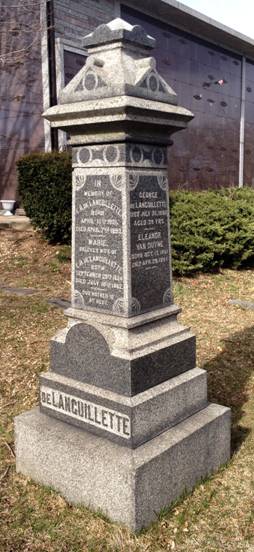
|
|
De
Languillette grave marker at Plain Lawn Cemetery, Hicksville, NY
Findagrave.com
|
|
*
|
Ernst
would survive another five years. He
continued to place advertisements in New York newspapers, as he had for
years since George left for Los Angeles, seeking a buyer for the soap
works which he no longer wanted to think about.
Unlike some of his contemporaries, such as Messrs. Herzog and
Heitz, he left no street behind to carry on his family name (thereby
saving the good people of Hicksville from a lifetime of spelling
errors). Regardless, he left
his mark. For example, older
firemen recalled that the first chemical apparatus in Hicksville's
department had been constructed in the yard behind Ernst's house.
Townspeople worried if there would be an agricultural fair now
that old Ernst had passed away.
It
is likely that Hicksville no longer cared, but accused murderer Sarah
Merrigan resurfaced in the news from time to time because of the 1873
killing. She did get a
second trial - which also ended in a hung jury.
What with her giving birth, legal delays, witnesses' having
moved abroad, illness or other unavailability of jurists and lawyers,
court calendar issues, etc., things dragged on as if Charles Dickens had
scripted them.
As the year 1878 began, she awaited a third trial, for which the
prosecution was to call fifty-two witnesses.
The defense's chief witness was in Ireland, and not inclined to
return in order to testify. At
one point, the defendant had spent twenty-one consecutive months in jail
while waiting for a trial to commence.
Finally, as February began, all parties concerned agreed that a third
trial would be pointless. The
court moved to not prosecute, and Mrs. Merrigan was set free.
I
suspect that the pseudonym "Madame Rosa" was laid to rest once the
aftermath of the "duel that never was" subsided.
This is not to say, however, that Amy Stevens, as she called
herself on the 1880 U.S. Census, had retired.
As opposed to labeling herself a "Clairvoyant," as she had on
the prior census, this time the woman in question said that she was a
"Doctress." I have yet
to find evidence of the name under which she continued to do business.
In the long letter to her which Stevens wrote before attempting to kill
himself, he had noted her misgivings concerning a man named Harper.
The letter suggested that she regretted having ended an intimate
relationship with this man after she met Edward Stevens.
Curiously, the name Harper did not appear when, for the newspaper that published the
letter, she listed all her husbands by name.
And yet, on the 1880 Census, she is listed as residing near the
northwest shore of Staten Island, living with one person, a daughter,
born about 1863 - Amy Harper.
That's All!
Many
sources are mentioned specifically in the text and captions above.
In general:
The primary sources were (duh) digitized period newspapers, found in
several online repositories.
After sustained prodding, both Ancestry.com
and FamilySearch.com yielded
supplemental information.
Munsell's 1882 History of Queens
County, New York provided background material.
The flintlock dueling pistol shown at the beginning of the article is in
the collection of the Metropolitan Museum of Art.
The image I used was excerpted from a photograph of a boxed pair,
found on Wikimedia Commons.
Thanks for reading to the
end.
There will be something else old
next month. Stay well!
|









